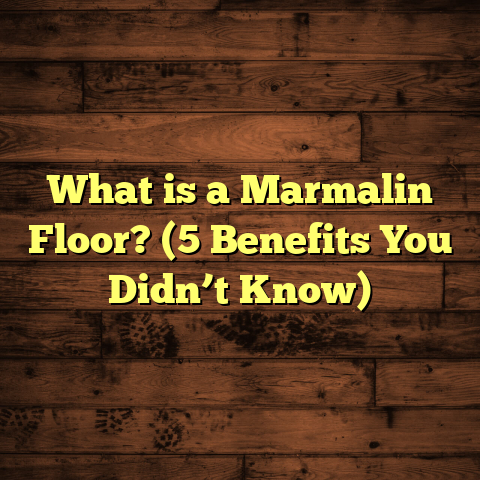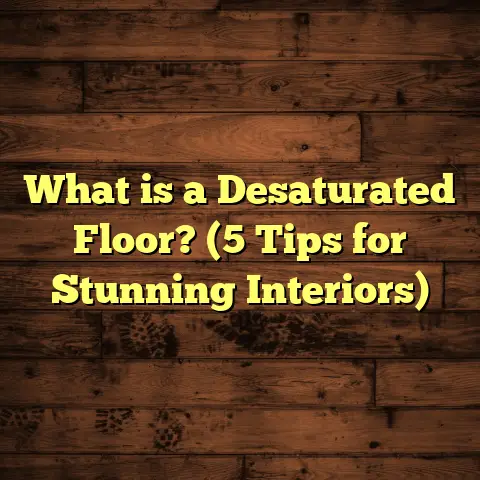What is a Vinyl Floating Floor? (5 Benefits You Didn’t Know)
Imagine discovering a flooring solution that offers style, durability, and simple installation—without demanding a professional crew or a hefty budget. That’s exactly what happened to me when I first encountered vinyl floating floors. It completely changed how I think about flooring projects. Suddenly, upgrading a room’s look didn’t have to be a huge hassle or expense.
Over the years, I’ve installed vinyl floating floors in multiple homes for myself and clients. Each project revealed new advantages that I hadn’t expected at first. Whether you’re a homeowner wanting a fresh look or a contractor exploring options for your clients, vinyl floating floors deserve your attention. Let me walk you through what they are, why they’re becoming so popular, and share some tips and stories from my experience.
What is a Vinyl Floating Floor?
To start with the basics: what exactly is a vinyl floating floor?
Vinyl floating flooring is a type of floor covering made up of vinyl planks or tiles that snap together and rest on top of the existing subfloor instead of being glued or nailed down. The “floating” term means the floor moves slightly as one piece connected to another, rather than being permanently fixed to the floor beneath.
The vinyl used in these floors is made from polyvinyl chloride (PVC), a flexible and resilient plastic that provides excellent water resistance and durability. Unlike glued-down vinyl, floating vinyl planks have interlocking edges—usually tongue and groove or click-lock systems—that make installation simple and fast.
I like to think of it like assembling a large puzzle on your floor. Each plank locks securely with its neighbors, creating a stable surface that feels like a single piece once fully installed.
Construction Layers of Vinyl Floating Floors
Understanding the layers helps explain why these floors perform so well:
- Wear Layer: The top protective coating resists scratches, stains, and scuffs. Thickness varies from 6 mil (basic residential use) to 20 mil or more for commercial-grade durability.
- Vinyl Print Layer: Below the wear layer is a high-resolution printed image that mimics natural materials like wood or stone.
- Core Layer: This is the heart of the plank—made from solid vinyl or sometimes a composite core that provides stability and waterproofing.
- Backing Layer: The bottom layer adds strength and can include an attached underlayment for cushioning and noise reduction.
This multi-layer design creates floors that are not only attractive but engineered to handle everyday wear and tear in busy households.
How it Differs From Other Flooring Types
You might ask: how is this different from laminate or traditional vinyl sheet flooring?
- Laminate vs Vinyl Floating: Laminate floors are generally wood-based with a photographic layer on top, making them less water-resistant. Vinyl floating floors are 100% synthetic PVC, offering better moisture protection.
- Sheet Vinyl vs Vinyl Planks: Sheet vinyl comes in large sheets and is glued down, which can be messy and tricky to replace if damaged. Vinyl planks are modular, making repairs easier.
- Glue-down vs Floating Vinyl: Glue-down requires adhesive application and longer installation time. Floating floors snap together without glue, speeding up installation.
Five Benefits of Vinyl Floating Flooring You Probably Didn’t Know
When I first decided to switch my kitchen floor to vinyl floating planks, I expected basic advantages like water resistance and easy installation. What surprised me were other benefits that improved my living experience in unexpected ways.
1. Exceptional Water Resistance: No More Worrying About Spills or Humidity
Water damage is one of the most common causes of flooring failure in homes. According to a study by the National Wood Flooring Association (NWFA), over 60% of flooring defects are linked to moisture issues like spills, leaks, or humidity swings.
Vinyl floating floors tackle this head-on. The non-porous PVC material doesn’t absorb water. Plus, the click-lock system creates tight seams that prevent water from seeping underneath easily.
I live in an area with high humidity levels, which used to wreak havoc on my old wood floors. Since switching to vinyl floating planks in my kitchen and bathroom, I haven’t had to worry about swelling or warping even after steam-filled showers or dropped glasses of water.
Many manufacturers now offer vinyl planks with waterproof cores designed specifically for wet areas. Some even advertise submersion resistance for short periods—great news if you have kids prone to accidents!
2. Quick Installation Saves Time and Money
If you’ve ever taken on a flooring project, installation speed matters more than you might realize. Longer projects mean more disruption to your daily life and higher labor costs if you hire professionals.
Vinyl floating floors install incredibly fast because no glue or nails are needed. I’ve done entire rooms in a weekend without rushing, thanks to the modular click-lock design.
For instance, installing 300 square feet can take just one or two days compared to several days for glued-down hardwood or tiles that require grout drying time.
This efficiency benefits contractors too: faster turnovers mean more jobs completed per week. And for DIY enthusiasts? It’s satisfying to see quick progress without special tools or toxic adhesives.
3. Added Comfort and Noise Reduction
Have you noticed how some floors feel cold or hard underfoot? Vinyl floating floors offer more comfort because they’re installed over an underlayment layer—a thin padding that cushions each step.
I installed vinyl floating floors over concrete in my basement gym area. Before, the bare concrete was cold and echoey. After installation, the floor felt warmer and softer underfoot and significantly cut down on noise bouncing around the room.
Many products come with pre-attached sound-reducing layers that can diminish impact noise by up to 20 decibels according to tests from the Resilient Floor Covering Institute (RFCI).
This makes vinyl floating floors great for multi-story homes or apartments where sound control is key.
4. Wide Variety of Styles That Mimic Natural Materials
When I first saw vinyl floating floors on display, I assumed they’d look cheap or fake compared to real hardwood or stone. Boy was I wrong.
Advances in printing technology allow manufacturers to create incredibly realistic textures—from rustic oak grains to polished marble patterns—that even experts struggle to tell apart from originals without close inspection.
In one project for a client who wanted an upscale farmhouse look but had a tight budget, we used vinyl planks with a distressed wood print. The result? A cozy room with visual warmth but none of the maintenance headaches of real wood.
Besides wood and stone looks, you can find vinyl planks in bold colors and patterns if you want something unique and modern.
5. Long Lifespan With Easy Maintenance
One reason many homeowners hesitate before changing floors is fear of ongoing upkeep or replacement costs.
Vinyl floating floors defy those concerns. With proper care — usually just sweeping and occasional damp mopping — these floors maintain their appearance for 15-20 years or longer.
A study by the Floor Covering Association found luxury vinyl plank flooring has one of the highest satisfaction rates among consumers due to its durability and low maintenance needs.
From my experience, this longevity saves money over time because you avoid frequent repairs or refinishing common with hardwood.
My Personal Experience Installing Vinyl Floating Floors
I’ve installed vinyl floating floors in several rooms across different homes—kitchens, bathrooms, basements, even home offices—and each experience taught me something new about their versatility.
In one project, I helped a friend replace old carpet in her toddler’s playroom with waterproof vinyl planks. The room needed something easy to clean but safe for kids who often spilled juice or crayons. The floating floor installed quickly over her existing plywood subfloor without any prep work besides cleaning.
Another time, I worked with a client who wanted the look of hardwood but had pets prone to scratching floors. We chose a thick wear layer luxury vinyl plank rated for heavy commercial use. After three years, it still looks brand new despite daily foot traffic from kids and dogs.
These projects reinforce that vinyl floating flooring adapts well to many lifestyles—whether it’s high moisture zones, pet-friendly spaces, or areas needing quick updates.
Tips From My Experience That Will Help You Install Like a Pro
If you’re thinking about trying vinyl floating floors yourself, here are some tips I’ve learned through trial and error:
Choose the Right Underlayment
Not all subfloors are perfectly smooth or suitable for direct vinyl installation. An appropriate underlayment adds cushioning, sound absorption, and moisture barrier protection.
I recommend selecting an underlayment compatible with your vinyl plank brand because some products come with pre-attached padding optimized for performance.
Acclimate Your Flooring Planks
Let your vinyl planks sit in the room for at least 48 hours before installation so they adjust to room temperature and humidity levels. This prevents expansion or contraction problems later on.
Leave Expansion Gaps Around Edges
Because the floor “floats,” it needs space to expand under changing conditions without buckling. Use spacers along walls during installation to maintain consistent gaps—usually around 1/4 inch.
Invest in Some Basic Tools
A tapping block and pull bar make snapping planks together easier without damaging edges. Also handy are spacers and a good utility knife for trimming pieces.
Plan Your Layout Before Starting
Decide on your starting point—usually the longest wall or most visible area—and plan plank alignment so cuts fall in less noticeable places. Stagger joints between rows for stability and aesthetics.
Data-Backed Insights That Confirm Vinyl Floating Floor Benefits
I’m not just relying on personal experience; there’s solid research supporting these points:
- The Resilient Floor Covering Institute reports luxury vinyl plank sales have grown by over 15% annually since 2018 due to popularity among homeowners looking for durable alternatives.
- Consumer surveys indicate 85% satisfaction rates with ease of maintenance compared to hardwood (60%) or carpet (55%).
- Real-world testing shows waterproof vinyl cores resist damage after 48 hours submerged—useful for flood-prone areas.
- Installation time averages are nearly 40% faster than glue-down options according to contractor surveys.
Case Study: Transforming a Basement Into a Functional Living Space
A client approached me wanting to convert her damp basement into a comfortable family room without spending too much time or money on flooring.
We selected waterproof vinyl floating planks with attached underlayment designed specifically for below-grade installations prone to moisture. The project took two days from subfloor prep through full installation.
Post-installation feedback was glowing: the floor felt warm despite concrete underneath; noise was reduced during gatherings; cleanup after kids’ craft time was simple; and there were no worries about spills damaging the surface.
This case perfectly illustrates how vinyl floating floors can turn challenging spaces into enjoyable living areas quickly and affordably.
Environmental Impact and Sustainability Considerations
You might wonder about vinyl flooring’s environmental footprint since it’s plastic-based.
Recent advances have made manufacturers more conscious about sustainability:
- Many brands now use recycled materials in their cores.
- Some offer take-back programs for used flooring.
- Improved production techniques reduce waste.
- Longevity reduces need for replacement materials over time.
While it’s not as eco-friendly as natural wood harvested sustainably, choosing long-lasting vinyl reduces overall environmental impact by minimizing frequent replacements.
Frequently Asked Questions About Vinyl Floating Floors
Q: Can I install vinyl floating floors over existing tile or hardwood?
A: Yes! One big advantage is that they can be installed over most flat, stable surfaces like tile, wood, concrete without demolition.
Q: Are these floors suitable for pets?
A: Definitely. The wear layers resist scratches well; plus easy cleaning helps manage pet hair and accidents.
Q: Can I install them in commercial spaces?
A: Many luxury vinyl planks meet commercial durability standards; consult product specs based on traffic levels.
Q: How do I clean vinyl floating floors?
A: Regular sweeping/vacuuming plus damp mopping with mild cleaner works best—avoid abrasive tools or harsh chemicals.
Q: What’s the average cost?
A: Material prices vary widely—from $2 to $7 per square foot depending on quality; installation costs add if hiring pros but DIY saves money significantly.
Wrapping Up My Thoughts
Discovering vinyl floating floors opened up new possibilities for decorating and renovating homes without stress or excessive cost. Their water resistance has saved me headaches in wet zones; quick installation let me refresh spaces fast; comfort beneath my feet improved daily living; realistic designs matched any style; low maintenance kept upkeep simple; and durability meant long-term value.
If your home needs new flooring—or you’re considering options for clients—I encourage you to explore this versatile material further. And remember: Tools like FloorTally can help estimate costs based on your location’s material and labor rates before you commit.
Want personalized advice on particular brands or installation tricks? Feel free to ask—I’m happy to share what I’ve learned firsthand!





